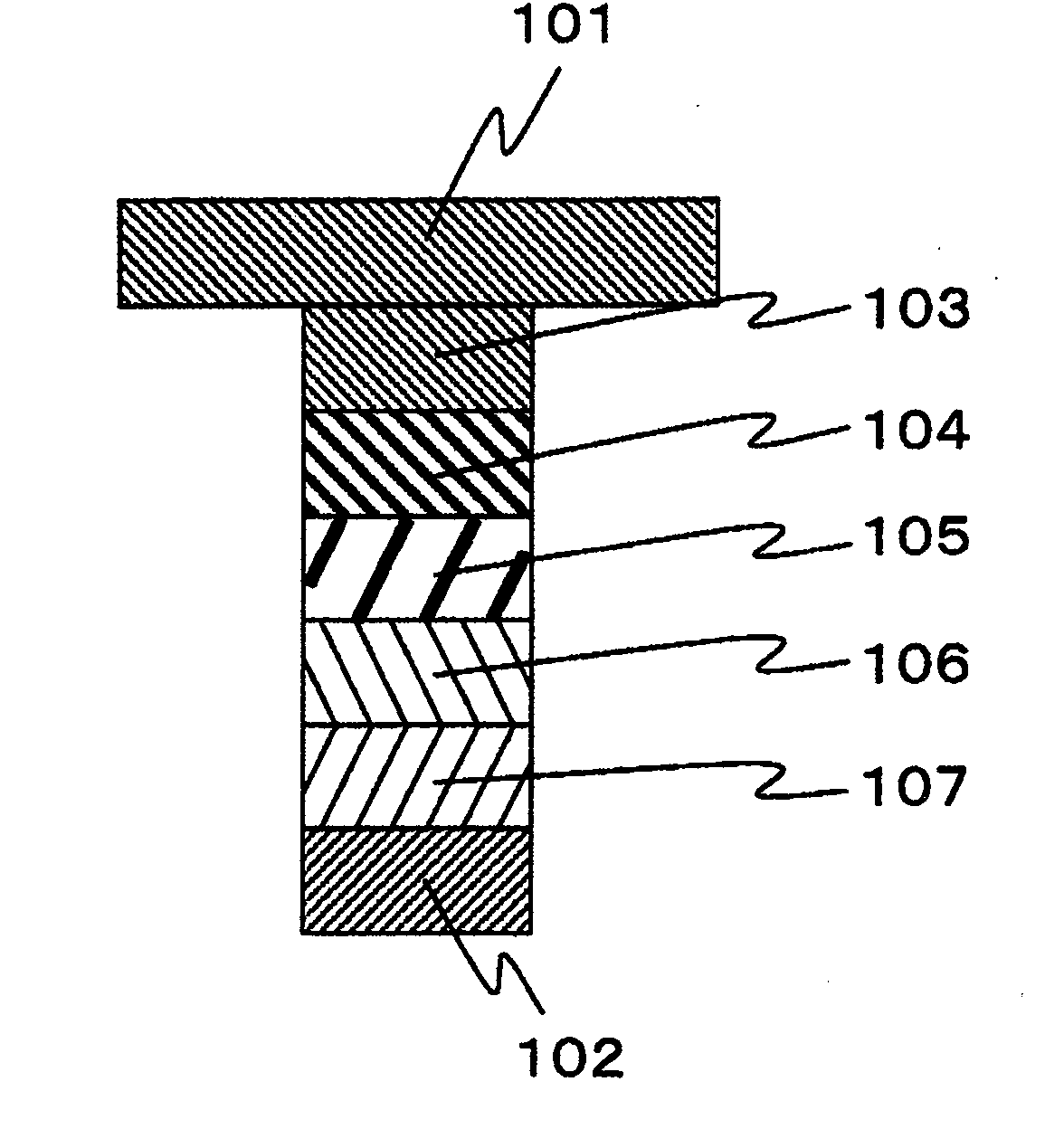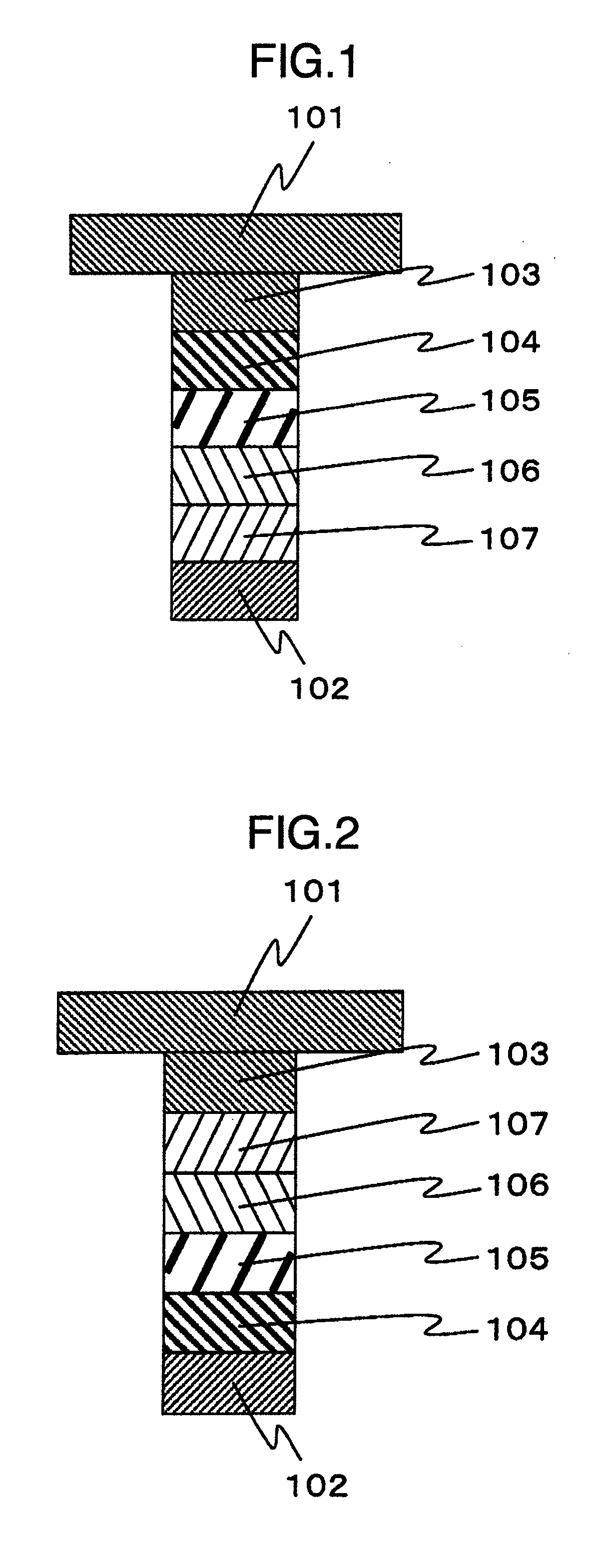Nonvolatile semiconductor memory device
a semiconductor memory and nonvolatile technology, applied in semiconductor devices, digital storage, instruments, etc., can solve the problems of rapid cooling operation necessary for bringing the nonvolatile recording material layer into the amorphous state, changes in the conditions of rewriting, and difficulty in rewriting. the effect of stable conditions
- Summary
- Abstract
- Description
- Claims
- Application Information
AI Technical Summary
Benefits of technology
Problems solved by technology
Method used
Image
Examples
embodiment 1
[0067]A method of manufacturing a memory cell of a nonvolatile memory will be described in detail with reference to the accompanying drawings. Throughout the drawings, members having similar functions are denoted by the same reference symbols and description of the similar members will not be repeated.
[0068]In the description of the following embodiments, generally, explanation of similar or same parts will not be repeated except when it is particularly necessary. With respect to the drawings referred to in connection with the described embodiments, cross-sectional views may not be provided with hatching for clarity of illustration, and plan views may be provided with hatching for clarity of illustration.
[0069]In this embodiment, as shown in FIG. 5, a memory cell is formed on a semiconductor substrate 201. The semiconductor substrate 201 is not only for a nonvolatile memory but also for a peripheral circuit to be formed therein for operating a memory matrix of the nonvolatile memory...
embodiment 2
[0105]In this embodiment, as shown in FIG. 22, memory cells are formed on a semiconductor substrate 201. The semiconductor substrate 201 is not only for a nonvolatile memory but also for a peripheral circuit to be fabricated therein for operating the memory matrix of the nonvolatile memory. The peripheral circuit may be fabricated by the use of the conventional CMOS technology. The positional relationship between the peripheral circuit and the memory matrix may be similar to that in Embodiment 1.
[0106]Referring back to FIG. 22 showing a structure at a step in which, on a semiconductor substrate 201, a first metal connection conductor layer 202, a nonvolatile recording material layer 207, a semiconductor layer 206, a second amorphous silicon layer 204 and a first amorphous silicon layer 251 are formed, in the described order. The first metal connection conductor layer 202 is made of tungsten and is formed by sputtering. More preferably, the layer 202 should be made of, for example, a...
embodiment 3
[0125]FIG. 31 is a perspective view of a semiconductor memory device, in which, on a semiconductor substrate 201, first metal connection conductor layers 210 serving as word lines in a memory matrix, pillar-shaped multi-layer films PU 5, third metal connection conductor layers 226 serving as bit lines in the memory matrix and insulating materials 229 and 228 are formed in a manner similar to that described in connection with Embodiment 1 with reference to FIGS. 5 to 18. Each of the multi-layer films PU 5 includes first and second poly-silicon layers 220 and 221, a semiconductor layer 222, a nonvolatile recording material layer 223, another semiconductor layer 222 and a second metal connection conductor layer 224.
[0126]The provision of the semiconductor layers leads to prevention of the degradation of the nonvolatile recording material layers stemming from the heat cycles at repetitive writing on the nonvolatile recording material layer and to the effect that the maximum number of ti...
PUM
 Login to View More
Login to View More Abstract
Description
Claims
Application Information
 Login to View More
Login to View More - R&D
- Intellectual Property
- Life Sciences
- Materials
- Tech Scout
- Unparalleled Data Quality
- Higher Quality Content
- 60% Fewer Hallucinations
Browse by: Latest US Patents, China's latest patents, Technical Efficacy Thesaurus, Application Domain, Technology Topic, Popular Technical Reports.
© 2025 PatSnap. All rights reserved.Legal|Privacy policy|Modern Slavery Act Transparency Statement|Sitemap|About US| Contact US: help@patsnap.com



